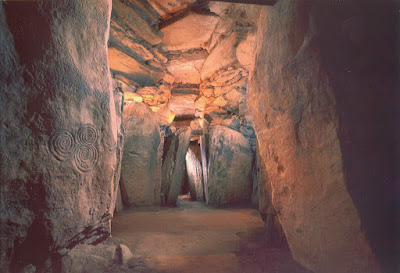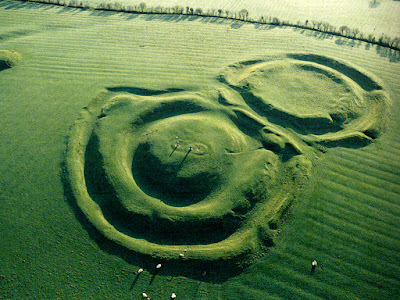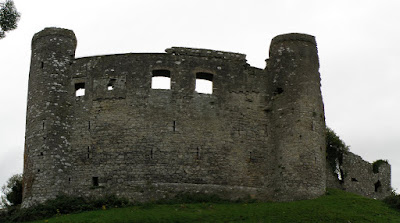Ireland Pt. 5
Completing the Circle
As we are driving around the different areas of the British Isles, we are always joking about how much slower traffic could get. In order of slowness, there's the big trucks, the car and trailers, the horse trailers, and the tractors. On the last leg of our trip it devolves into even worse, the huge truck overloaded with hay, and just when we think we're clear of that, we run into the slowest form of all, horse and buggy... right down the middle of the main road.
Navan
Navan is a town central to the Boyne Valley north of Dublin, and within an hour of the airport. Our B&B host in Navan told us that the GPS coordinates provided in the book would put us behind their property, so he gave us better ones that would put us in front of their house. The problem is, I think he was dyslexic, the number's he gave us directed us behind some new mall that was under construction. Frustrated we put the original coordinates in, and then ended up asking a resident by Athlumney castle for directions to the B&B. He pointed at the back of the house, "You can't get there from here", and then told us the roundabout loop we needed to make to actually get there.

When you are doing any kind of traveling that involves lots of driving around, or jumping train to train, you never know when you might find a place to stop for a bite, or grab a drink. It's always a good idea to have a bag of snacks and drinks (pop/water/iced tea). You never know when you might need a meal consisting of crackers, chips and chocolate bars.
Athlumney Manor B&B seemed like a nice B&B in the guidebook, one of the attractions of their B&B is the view of Athlumney Castle from your room. Not only is the room a little run down and dated, but the castle is not visible from the room as advertised. ahhh, the old bait and switch. Since we didn't actually arrive at the room until 9:30, tonight is crackers and chips for dinner...
we were too exhausted to walk into town and go searching for food.
In the morning we woke up to our last drizzly day in Ireland, sniff, sniff.
Boyne Valley
Our first stop in the Boyne Valley is Brú Na Bóinne. It is a complex of Neolithic chamber tombs, standing stones, henges and other prehistoric enclosures, some dating from as early as the 35th century BC. The site predates the Egyptian pyramids and was built with sophistication and a knowledge of science and astronomy, which is most evident in the passage grave of Newgrange.
All access to Newgrange is done via guided tours, and you are driven to each area by bus. We were lucky to get a 10:15 time slot, one of the first tours before the big tourist buses start arriving. We chose to only visit one tomb so we would have time to see other sights in the area on our last day. There is three main megalith sites that have significant archaeo-astronomical significance. Newgrange and Dowth have Winter solstice solar alignments, while it is claimed Knowth has an Equinox solar alignment. We chose to visit Newgrange, a passage tomb that is over 5,000 years old, and the only one that allows you to enter the famous passageway.
A group of 24 is loaded into 2 buses and we are taken to Newgrange. The Newgrange mound is 76m (250ft) across and 12m (40ft) high, we have to wait for the first group to enter the tomb and come out before it is our turn. Before we enter a guide tells us about the history of the tomb, the construction, and the eventual discovery in the 17th century, and restoration between 1962-1975.
There is spiral and diamond motifs engraved on the entrance slab, described as "one of the most famous stones in the entire repertory of megalithic art", it includes a triple spiral motif, found only at Newgrange and repeated along the passage and again inside the chamber
Just as the rain picked up it was our turn to go into the tomb. You enter down a very narrow 18 meter (60 foot) passage, turning sideways to fit, eventually entering the central tomb chamber. The burial chamber has a stacked roof which rises steeply upwards to a height of nearly 6m (20 ft). The roof has remained essentially intact and waterproof for over 5,000 years, amazing.

Newgrange was built in such a way that during the 5 days of winter solstice (the shortest day of the year), at sunrise the light enters a roof box above the door, and a narrow beam of sunlight travels down the long passageway and illuminates the floor of the chamber for 17 minutes before returning to black. Using electric lights, the guide recreates this moment for us. A lottery is conducted every year for a small group to enter the chamber during this very rare solar alignment.

The area around the mound is also very interesting, a free-standing circle of large stones encircles the mound, of which there are twelve of a possible thirty-seven remaining. There is also a small stone house resembling an igloo on the hillside, but no info is provided about it.
Looking out at the countryside from the Newgrange hill, you can see other mounds that haven't been uncovered yet, but mostly you see farmland, and horses, and heck of a lot of sheep.
As we are watching two stallions horsing around, the bus pulls up and it is time to go.
To the north of Slane village rises the Hill of Slane, where St Patrick is supposed to have lit a fire in 433 AD to celebrate Christian traditions, beating out the Pagan celebrations much to the dismay of King Lóegaire, the high king of Ireland. At the peak of the hill is an Old cemetery, and ruins dating back to the 12th century, including the 16th century Slane friary and college. We also wanted to check out Slane Castle, but it was all closed up, even though the sign said OPEN.
From one cemetery we traveled to another, Donaghmore Church and Round Tower remains are situated a little more than a mile from Navan, on the road to Slane. This religious establishment owes its origin to St. Patrick, who founded a monastery here in the 5th century.
The round tower was not built until the 11th or 12th century, it is unique with its raised relief of a crucified Christ over the door, a little hard to see as it has weathered so much.
Next up is Trim Castle, aka King John's Castle, the largest Norman castle in Europe, and Ireland's largest castle. The 12th century Trim Castle was constructed over a thirty-year period by Hugh de Lacy and his son Walter, and served as a strategic defensive and administrative point for hundreds of years. Trim Castle's remains overlook the rapidly flowing River Boyne, which during Medieval Times was used to reach the castle by boat from the Irish Sea, 25 miles away.
We had to wait for a tour inside the main castle, so we grabbed a quick bite around the corner at the combination visitor center, genealogy center and Ramparts coffee shop, before being escorted around the remains of the castle. They have intentionally left the castle in it's partially ruined state so that it retains its historical status. Our guide uses an enormous Iron key to enter the main door, from that point on he focused on stories of pooh, it was a little weird.
As we worked our way up in the castle, the views over the castle grounds improve, and the sights inside of the castle become more interesting, including graffiti from the 1800's.
Our guide made sure we learned all about Trim Castle and it's history... We learned about how darker pooh means you have a healthier diet, we learned how pooh was spread on the walls or left in a bucket so people could know how regal their diets were. We learned that clothes were left over the toilet holes so the ammonia and stench could kill off bugs. We learned the non-pooh related fact that Trim Castle was one of the main castles used in the movie 'Braveheart'.
The Yellow Steeple (named for the way the sun sets and rises on it in the giving it a yellow colour), is the remains of a 14th century abbey on a hillside across the River Boyne from Trim Castle, is the tallest building in Trim and can be seen for kilometers around the town.
There are numerous interesting structures around the castle including Talbot's Castle (St. Mary's abbey) built in 1415 and later converted into a school using the ruined materials from the Yellow Steeple. Sheep Gate, which is not really a sheep gate, it's the last remaining gate of the city wall that existed in medieval times. The Bridge over Boyne, and St. Patrick's Church which dates from 1891, when the first stone was laid. We were so busy admiring all these sights that we didn't notice the "Pay and Display" sign where we parked. As we head back to our car there is a Garda (Irish police) handing out parking tickets, luckily he hadn't got to our car yet... whew.
From Trim Castle we worked our way East and somehow missed Bective Abbey, and ended up at the Hill of Tara. It contains a number of ancient monuments, and, according to tradition, was the seat of the High King of Ireland. During the turn of the 20th century the Hill of Tara was excavated by British Israelists who thought that the Irish were part of the Lost Tribes of Israel and that the hill contained the Ark of the Covenant. Buried in the hill are ring forts and tombs, which in a lot of cases, the only hint they exist is the raised shapes in the grass, most evident from above.


A prominent mound turns out to be a small Neolithic passage tomb known as Dumha na nGiall (the Mound of the Hostages), which was constructed around 3,400 BC. It has a short passage which is aligned with sunset on the true astronomical cross-quarter days of November 8 and February 4, the ancient Celtic festival days of Samhain and Imbolc. Nearby is a standing stone, which is believed to be the Lia Fáil (Irish Stone of Destiny) at which the High Kings were crowned. According to legend, when the true king of Ireland stood on the stone, it would roar.
The Hill of Tara is featured in the 1958 Disney film Darby O'Gill and the Little People. The whole hillside is like walking through a mine field, but it's not little people you have to watch out for, as there is lots of sheep, which means lots of sheep whoopsies (that's what they call them). There is a few park benches to sit and admire the view from the hill, but after watching sheep rubbing their asses on benches, we decided to stand. When the sheep started getting frisky, we left.
The old disused St. Patrick's Church is now the visitor centre, there is some interesting grave markers and standing stones around the old church, but the statue of St. Patrick holding the symbolic Irish shamrock indicates the impact he had on the area, and the country.
After driving around a while, I finally stopped at a pub and asked where Bective Abbey was. It was about 500 metres down the road, and we had driven right past it earlier in the day. With it's large stone walls and hedges we had somehow missed it and kept on driving, doh! We parked on the side of road, as close as we could get to the hedges, and just as we are getting out of the car, a golden lab runs through a small door in the gate onto the road. Worried he is going to get hit by a car, we quickly convinced him to get off the road, and climbed through the small door in the gate.
Bective Abbey was founded in 1147, set in the middle of a farmer's pasture, nothing remains except old ruins and walls. It was also used as a location for the Mel Gibson movie 'Braveheart'.
We were trying to figure out how to get into the Abbey, when our labrador guide dog, walked over to the rock fence and went up a set of steps built into the wall, and back down the other side. We followed him, and then he followed us all around the Abbey with a giant rock in his mouth.
There was some impressive carvings and structures in the abbey, as we wandered around it and into the central courtyard. The lab was only distracted when another group of people showed up and he started following them. When they were leaving he followed them to the gate, and they tried to trick him by quickly closing the little door, but he had other routes to the road and just ran further down the fence. When we left we tried to trick him too... I threw his rock, and then we bolted for the gate, but he's too smart, as we are driving away, he is running alongside our car.
It seemed sad to leave our lab guide dog and his scenic farmlands behind, but we had one more stop to make. As it turns out, Ireland has lots of castle guide dogs, who knew?
We ran into similar problems trying to find Dunmoe castle, and had to ask in a gas station. Turns out it's not really a featured castle from a tourist standpoint, and we have to work our way through some classic irish farmland to find it. It appears to be Private property, surrounded by barbed wire fences. But I notice there is a sign on a gate that is closed with wires, angling is allowed with permit only, well if they let fishermen in, then we should be able to go. I twist off the wires and squeeze through, Norine thinks its a bad idea, but she follows me into a field of cow patties.
As we are carefully trekking across the cow pasture, a Jack Russell terrier comes whipping up at full speed. He runs around us about 4 or 5 times, and then runs off showing us where to go. Just like the Golden Lab at Bective Abbey he leads us to a series of hidden steps, and he shows us the other side of the castle. The entire time we are exploring the dog is running around at a million miles an hour, stopping only to roll around on his back and leap back up... hilarious.
Dunmoe Castle is a 15th century castle, prominent during the Cromwell era when he tried to attack it in 1649. It survived Cromwell's attack and the Battle of the Boyne several years later, but was destroyed by fire in the 18th century.

The views from Dunmoe castle are amazing, you look over a flowing river, nestled between trees and a pasture of horses. Across the river Blackwater is the Ardmulchan House a bricked mansion.
Beside the castle is a grave stone with a skull and crossbones reading "Here Lyeth y body of Thomas Casserly who departed this life the 5 day of Aprel in the yeare 1722"... freaky.
As we are walking to our car, back across the field of cow-pies , our little tour guide disappears.
As I am rewiring the gate, I notice an ancient man waiting by our car, uh-oh, we're in trouble for trespassing. As we walk up to him he waves and says in a very thick Irish accent "You know, there's an easier way, not so messy", and points down the other way, grinning with no teeth.
He asks us if we are from Cork, since that is on our license plate, and after telling him we are from Canada, we hear all about his adventures, his son, and his dog 'Corky'. Out steps the little Jack Russell, and I laughed when I told him he was touring us around the castle. He scolds Corky, "I told you not to tour strangers around the castle anymore". He tells us "He's a good friend to me, but I have to be careful, cause he will try to get in strangers cars" and then Corky jumped in our car. ![]() I carefully shooed him out, said goodbye to our ancient new friend, and we headed home.
I carefully shooed him out, said goodbye to our ancient new friend, and we headed home.
Our last part of the day was spent wandering around our current and last home base of Navan. It just seemed appropriate that the last church we visited would be called St. Mary's Church.
Our next stop was the cutest McDonalds ever, for a much needed drink and snack. After a refreshing break we visited the town hall and some other historic buildings, most of them closed.
Our last dinner in Ireland was at an italian place, on the river overlooking some ancient bridges, the food was great, the service... not so much. Oh well, saved on a tip again.
After dropping our car back at the B&B, we decided to walk to Athlumney Castle, it was a bit of a walk there. There wasn't much to the castle, a mid-fifteenth-century tower house. The mansion was burnt in 1649 to prevent Oliver Cromwell from getting any shelter or subsistence there.
We decided to continue our circle back to the B&B, and found out there was a much shorter route on the way back. Oh well, a walk past thatch roofed houses and old castles to end the last night of our trip is a nice way to wrap up a trip. Back in the room, a couple doves coo us to sleep.
In the morning we drove to Dublin airport which was only 40 minutes away, our car checked out ok, and 2726 km later, our circle of Ireland was complete. Bused to the airport and a short wait later, we flew off at 1:00pm for an uneventful but long flight. The flight was made longer by an electrical problem resulting in no audio for the three movies on our last ever flight with flyglobespan.
Two very long flights, 32 days, 70 Castles/Palaces/Forts, 70 Churches/Abbeys/Cathedrals, over 3000 pictures, 6 ferries, 2 cars, and almost 7000 kilometers (4350 miles) of driving we arrived home, exhausted but enriched... what an amazing trip, what an amazing part of the world.


